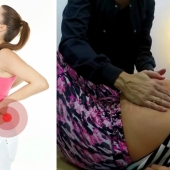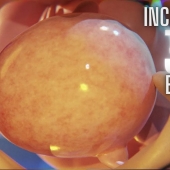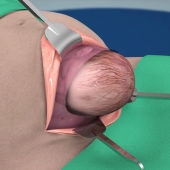A Caesarean section (often C-section, also other spellings) is a surgical procedure in which one or more incisions are made through a mother's abdomen and uterus to deliver one or more babies.
A Caesarean section is often performed when a vaginal delivery would put the baby's or mother's life or health at risk. Some are also performed upon request without a medical reason to do so.The World Health Organization recommends that they should only be done based on medical need.
The video describes a procedure known as a Caeserean section conducted to deliver a baby that cannot be delivered by natural means.
Some may be planned or may occur when complications such as dystocia, placenta previa or foetal distress occur during the birthing process.
Dystocia is also called long non-progressive labour and occurs when the baby’s head cannot pass through the vaginal opening or the baby is in an unfavourable position for birth.
Other indications include:
- Overly large baby
- Fetal distress
- Cord prolapse
- Uterine rupture
- Induction failure
- Multiple births
- Pre-eclampsia
- Uncontrolled Hypertension
- Contracted pelvis
- Genital herpes
- HIV
- Baby is in a breech position
- Previous invasive uterine surgery
- Baby has a known illness
Placenta previa is a condition where the placenta either partially or completely blocks the vaginal opening. Foetal distress occurs when the health of the baby is in jeopardy due to the umbilical cord wrapping itself around the child’s neck or due to inadequate blood flow due to the detachment of the placenta.
Other conditions that may require a C section are also discussed such as multiple births, tumours in the uterus, genital herpes or medical problems. Ultrasound testing and a foetal heart moniter can us be sued to test for the possibility of a C-section.
Types of Caesarean Sections
Classical C-Section: Because of the commonness of complications, classical C-sections are rarely performed these days. They involve a midline longitudinal incision that makes a larger opening to deliver the baby. There are specific medical indications for the use of this type of incision. It is never permissible to attempt a VBAC after a classical uterine incision.
Low transverse uterine incision: This is the most commonly performed procedure today. It involves a crosswise cut just above the edge of the bladder. This procedure is proven to result in less blood loss, and women who have it may be allowed to have VBAC with future pregnancies.
Emergency C-Section or Crash C-Section: This can occur for a variety of reasons, but it is always done immediately.
Repeat C-Section: A repeat C-section happens when a patient has had previous C-sections. Generally, doctors will re-enter the womb through the old scar.
Caesarean Hysterectomy: This is a C-section followed by the removal of the uterus. If the placenta cannot be separated from the uterus, or if there is intractable bleeding, a hysterectomy will follow the removal of the baby. This is a life-saving procedure.
Risks of C-Sections
- Infections
- Blood clots
- Excessive bleeding and/or blood loss
- Longer recovery
- Longer hospital stay
- Postpartum pain
- Injury to bladder or bowels
- Post-operative adhesions
- Incisional hernias
- Emergency hysterectomy
- Placenta accreta
- Placenta previa
- Malpresentation
- Uterine rupture
- Preterm birth
- Prolonged labor
- Low birth weight
- 2582 views













